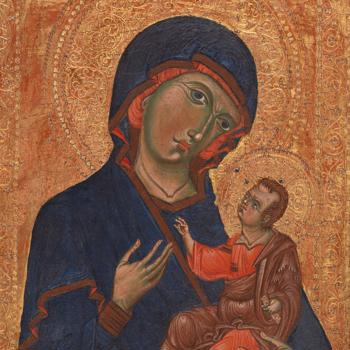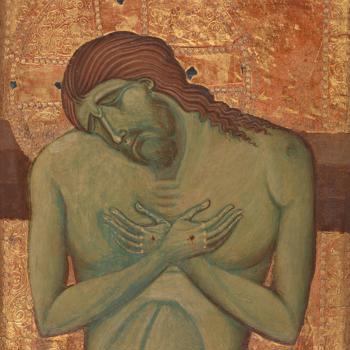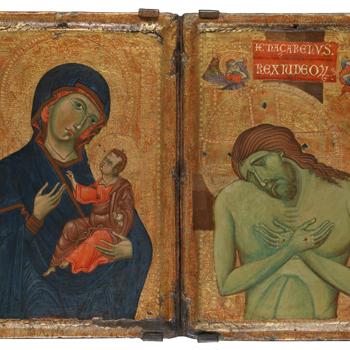Master of the Borgo Crucifix (Master of the Franciscan Crucifixes), The Virgin and Child
Umbrian Diptych
These panels once formed the left and right wing of a diptych, a painting made up of two parts joined by a central hinge. Holes on the left edge of the panel depicting the dead Christ match up with those at the right edge of the panel with the Virgin and Child; these once held hinges. Both panels have the same dimensions and the backgrounds are decorated with the same patterns and markings. The reverses are both painted to imitate red porphyry, a type of stone.
The images belong to the Byzantine (Eastern Christian) tradition. The diptych may have been made for a Franciscan friar – a member of the religious order which followed the teachings of Saint Francis and placed particular emphasis in their prayer upon Christ’s suffering. The Order’s presence in the eastern Mediterranean after the Fourth Crusade of 1204 (one of a series of medieval religious wars) meant that they would have been familiar with Byzantine imagery.
Housed in different collections for many years, these two panels once formed the left and right wing of a diptych – a fact only discovered in 1999. They were joined by a central hinge so the painting could be folded up and carried when travelling, for use as a personal private altarpiece wherever the owner might be.
Holes on the left edge of the panel depicting Christ after his death match up with those at the right edge of the panel with the Virgin and Child; this is where the hinges once were. The panels have the same dimensions and the gold leaf backgrounds are decorated with the same scrolling patterns and markings. Their reverses are painted to imitate red porphyry, a type of stone – further evidence that they belong together.
The image of Christ after his death was known as the ‘Imago Pietatis’ (‘image of pity’) or the Man of Sorrows; it is based upon an image from Byzantium, the Eastern Christian empire. The image of the Virgin Mary derives from a Byzantine icon called the Virgin Hodegetria, where she points to the Christ Child who makes a blessing gesture with his right hand. The pairing of the Man of Sorrows with the Virgin and Child can also be found in Byzantine painting; there is, for example, a double-sided icon in the Byzantine Museum, Kastoria, Greece, where the front is painted with the Virgin and Child and the reverse with the Man of Sorrows. Our painting is the earliest known diptych pairing both images. The Man of Sorrows became very popular in western Europe in the thirteenth century.
The diptych may have been made for a Franciscan patron. The Man of Sorrows was popular with the Franciscan Order, who placed particular emphasis in their prayer upon the suffering of Christ. The patron might have specified that the artist copy a specific Byzantine image that he knew: our painting appears to be a careful copy of another work. Infrared reflectography has shown that detailed outlines of the figures were incised into the ground as a guide before painting began, but we don‘t know if the artist was following a single painting or images from two separate objects. The Order’s presence in the eastern Mediterranean after the Fourth Crusade of 1204 – one of a series of religious wars which resulted in the Latin conquest of the Byzantine capital Constantinople – meant that they would have been very familiar with Byzantine imagery.
The panels have been linked to the Master of the Borgo Crucifix by comparison to figures – particularly Saint John the Evangelist and the Virgin Mary (now in the National Gallery of Art, Washington D.C.) – from a painted Crucifix once in the church of Santa Maria in Borgo, Bologna, after which the painter is named. All share softly rippling draperies, delicate hands and fingers and similar facial features, including the strong ’v' shape between the eyes.



